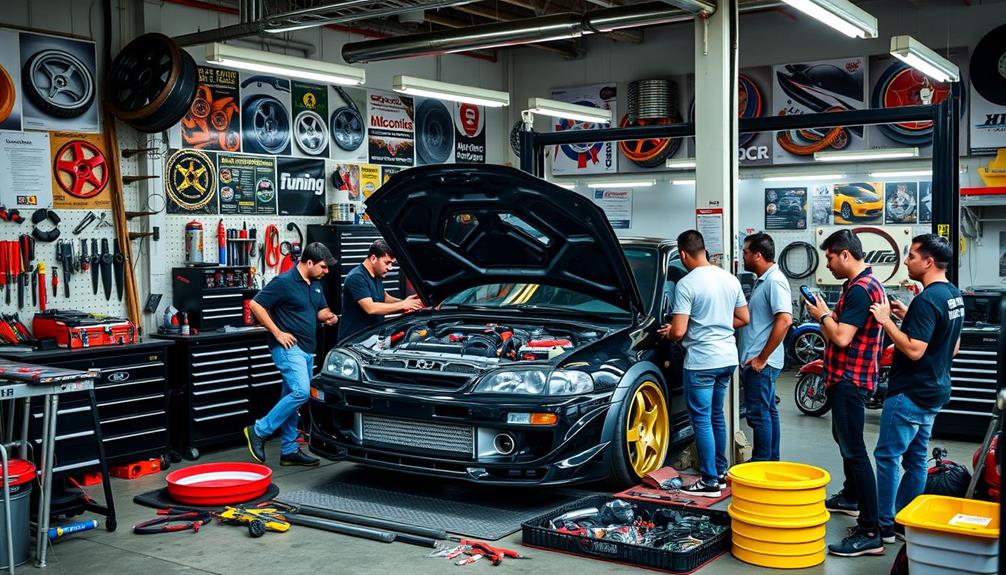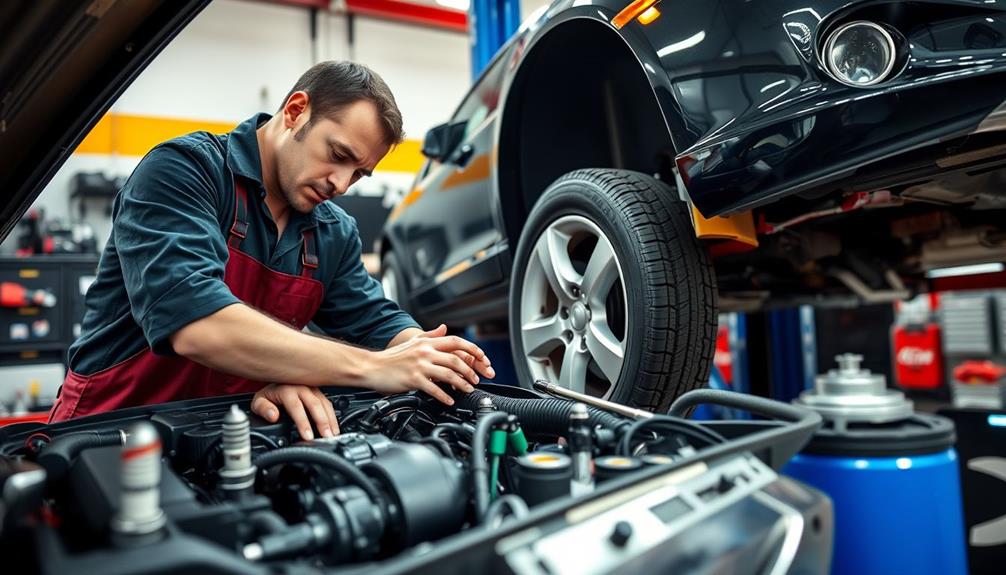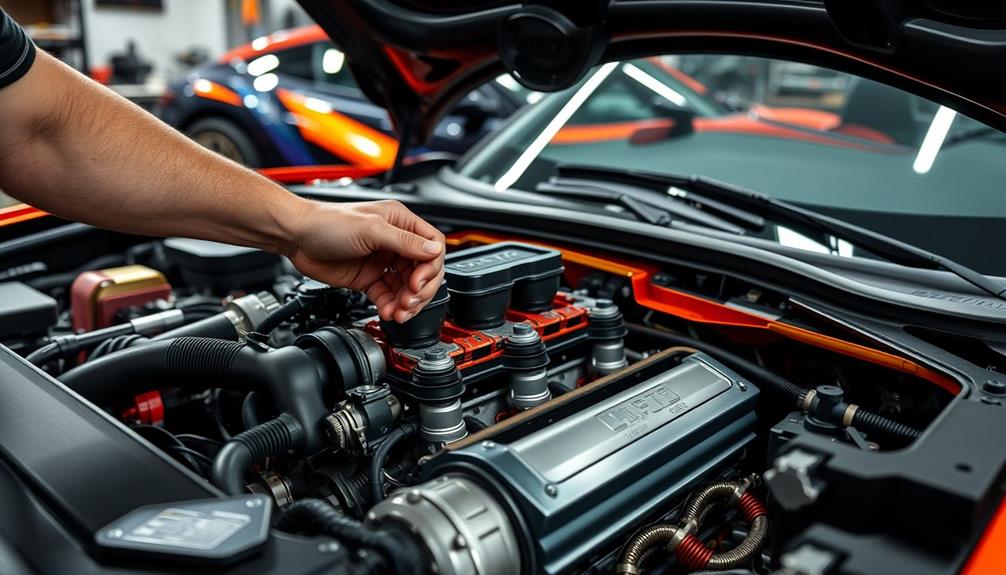Car tuning transforms your vehicle's performance through strategic modifications. You can start with simple tweaks like ECU remapping, which adjusts your engine's parameters for notable power increases—often between 10-30%. As you explore more advanced options, stage tuning offers a structured approach, from basic enhancements to more complex upgrades like turbochargers and performance exhausts. Each modification works together to optimize power, efficiency, and handling. You'll not only experience a more responsive ride but also gain valuable insights into your vehicle's dynamics. Keep going, and you'll uncover even more fascinating details about the art of car tuning.
Key Takeaways
- Car tuning modifies vehicles to enhance performance, handling, and appearance through engine and suspension adjustments.
- ECU remapping optimizes fuel delivery and ignition timing, resulting in significant horsepower and torque gains.
- Performance upgrades, such as air filters and exhaust systems, improve airflow and combustion efficiency.
- Turbocharged vehicles benefit from intercoolers and upgraded turbochargers, increasing power output and maintaining ideal temperatures.
- Stage tuning categorizes modifications, allowing enthusiasts to choose upgrades based on their vehicle's needs and performance goals.
What Is Car Tuning?
When you think about car tuning, it's all about modifying your vehicle to enhance its performance, handling, or appearance. Car tuning can involve a variety of modifications, including engine upgrades, suspension adjustments, and aesthetic changes like body kits or custom paint jobs. With the right car tuning illustration tips, you can visualize the potential changes to your vehicle before making any major decisions. Whether you’re looking to improve your car’s speed and power, or simply want to give it a more unique look, car tuning can help you achieve the desired results.
Car tuning can involve numerous methods, but two common types are engine tuning and suspension tuning. Engine tuning focuses on improving your vehicle's power and efficiency, often through modifications like turbocharging or chip tuning. These changes can notably boost your engine's performance, making your drive more exhilarating.
To guarantee a successful tuning experience, it's important to understand your vehicle's specifications and common financial terms that may impact the cost of modifications.
Suspension tuning, on the other hand, targets handling and stability. By altering vehicle parts like shocks, springs, and sway bars, you can improve cornering ability and ride quality. Each adjustment contributes to a more responsive and enjoyable driving experience.
It's vital to remember that car tuning isn't just about performance; you must also consider legal compliance. Regulations concerning safety and emissions can vary by region, so verifying your modifications meet these standards is critical.
Popular choices for tuning often include German models like Audi, BMW, and VW, as they offer extensive aftermarket support. Ultimately, car tuning allows you to personalize your ride while enhancing its overall capability and appeal.
Understanding Stage Tuning

When you're considering stage tuning for your vehicle, understanding the basics is essential.
Stage 1 modifications offer simple upgrades like ECU remapping, while Stage 2 enhancements involve more complex changes that increase performance considerably.
Knowing the differences between these stages helps you choose the right path for your tuning goals.
Stage Tuning Basics
Understanding stage tuning can transform your driving experience, allowing you to tailor your vehicle's performance to your preferences. Stage tuning categorizes modifications into levels, making it easier for you to choose the right performance upgrades.
Stage 1 typically focuses on lighter enhancements, such as ECU remapping and performance air filters, which don't require significant hardware changes. This is a great starting point if you're looking to boost horsepower and torque without diving into extensive modifications.
As you progress to Stage 2, you're looking at more thorough changes that may involve upgrading components like performance exhaust systems and intercoolers. These upgrades help maximize airflow and overall engine efficiency, pushing your vehicle beyond factory limitations.
It's essential to recognize that each tuning stage can vary in definition and implementation based on your specific vehicle and tuner, meaning your experience may differ from others.
In both stages, ECU remapping plays a critical role by adjusting engine parameters like fuel delivery and timing, ultimately enhancing your driving dynamics.
Stage 1 Modifications
For those keen to enhance their vehicle's performance without diving into complex modifications, Stage 1 modifications offer an accessible entry point. This tuning stage typically involves light upgrades that focus on enhancing performance through software adjustments and basic hardware improvements. Key components include ECU remapping, performance air filters, and cat-back exhaust systems. These upgrades refine engine parameters like fueling and timing, leading to noticeable gains in horsepower and torque.
Here's a quick overview of common Stage 1 modifications:
| Component | Benefits | Considerations |
|---|---|---|
| ECU Remapping | Increases power and efficiency | Vehicle compatibility needed |
| Performance Air Filters | Improves airflow and engine response | Verify proper fitment |
| Cat-Back Exhaust Systems | Enhances exhaust flow and sound | Check local noise regulations |
Stage 1 tuning is often regarded as entry-level, making it suitable for enthusiasts with minimal mechanical knowledge. While generally safe and reliable, careful consideration of vehicle compatibility and tuning practices is essential to guarantee ideal results. By starting with these modifications, you can enjoy a more spirited driving experience without the need for extensive mechanical changes.
Stage 2 Enhancements
Stage 2 enhancements take your vehicle's performance to a whole new level by removing factory limitations and implementing more aggressive modifications. This stage of tuning typically involves mechanical upgrades paired with ECU remapping, guaranteeing your car can handle the increased demands of these enhancements.
Common components in Stage 2 tuning include de-cat pipes, upgraded air intakes, and performance exhaust systems. These elements work together to maximize airflow, boosting overall engine performance.
If you own a turbocharged car, you'll particularly benefit from intercoolers or supercharger charge-coolers. These components optimize air density, which enhances both power output and efficiency during high-demand situations.
You can expect significant gains in horsepower and torque with Stage 2 modifications, especially compared to Stage 1. However, it's crucial to recognize that definitions of Stage 2 can vary between vehicles and tuners.
To confirm compatibility and effectiveness, always consult with professionals who understand the specific requirements of your car. With the right approach, Stage 2 enhancements can transform your driving experience, releasing the full potential of your vehicle.
ECU Remapping Basics

When you think about ECU remapping, it's crucial to understand how the engine control unit works.
This software modification can greatly enhance your vehicle's performance by adjusting key parameters like fueling and timing.
Let's explore the various remapping techniques that can help you release your car's potential.
ECU Functionality Overview
Understanding the functionality of the Engine Control Unit (ECU) is vital for anyone interested in car tuning. The ECU acts as the brain of your vehicle, managing engine performance by controlling critical parameters like fuel delivery, ignition timing, and air intake. By optimizing these settings, you can greatly enhance your car's overall performance.
One of the key adjustments you can make through ECU remapping is modifying the air-fuel ratio. This adjustment guarantees that your engine receives the ideal mixture of air and fuel for combustion, which can lead to increases in horsepower and torque.
Additionally, if you have a turbocharged engine, you might also tweak the boost pressure to maximize performance.
Using modern remapping techniques, you can access your ECU through diagnostic ports with specialized tuning tools. These tools allow for precise adjustments and continuous data monitoring, guaranteeing that each tweak is effective.
When done correctly, proper ECU remapping not only enhances engine performance but can also improve fuel efficiency, making your driving experience more enjoyable and economical.
Remapping Techniques Explained
ECU remapping is a powerful way to release your vehicle's potential by directly modifying the software that controls engine performance. This process optimizes parameters like fueling, timing, and boost pressure, resulting in noticeable increases in horsepower and torque, especially in turbocharged engines.
Here's what you can expect from remapping techniques:
- Improved Fueling: Adjustments to the air fuel ratio enhance combustion efficiency.
- Increased Horsepower: Stage 1 remapping can yield gains of 10-30% in power.
- Real-Time Data Logging: Modern techniques monitor engine performance to guarantee safe adjustments.
- Boost Pressure Optimization: Fine-tuning boost pressure can considerably enhance performance.
- Compatibility Checks: Tailored remaps work best with existing modifications like turbochargers and intercoolers.
Using diagnostic tools that connect to your vehicle's OBD-II port, the remapping process allows for efficient data transfer and precise adjustments.
Keep in mind that a well-executed ECU remap not only improves engine management but also enhances the benefits of your performance upgrades.
With careful consideration and monitoring, you can free your vehicle's true potential.
Key Components of Tuning

Tuning your car involves several key components that work together to enhance performance and handling. Understanding these elements is vital for achieving the desired improvements in your vehicle.
| Component | Description |
|---|---|
| ECU Remapping | Adjusts engine parameters like fuel and timing for peak performance, especially in turbocharged vehicles. |
| Performance Air Filters | Improves airflow into the engine, allowing for better combustion and increased power. |
| Turbocharger Upgrades | Larger turbos increase air intake and boost pressure, essential for maximizing engine output. |
| Fuel System Upgrades | Larger injectors and upgraded fuel pumps guarantee adequate fuel delivery, preventing overheating at higher power levels. |
| Suspension Tuning | Adjustable coilovers and anti-roll bars enhance handling and stability for precise control during driving. |
Performance Upgrades Explained

Performance upgrades play a vital role in enhancing your vehicle's capabilities, building on the key components of tuning. By implementing these modifications, you can greatly boost your car's performance, especially if you're starting from a solid foundation.
Here are some common performance upgrades to evaluate:
- ECU Remapping: Optimizes engine parameters for increased horsepower and torque.
- Upgraded Fuel Injectors: Essential for ensuring your engine receives adequate fuel supply during high-performance demands.
- Cat-Back Exhaust System: Improves gas flow, enhancing the engine's efficiency and sound.
- Intercoolers: Helps maintain ideal air temperature, essential for turbocharged engines to perform at their best.
- Turbocharger Upgrades: Installing a larger turbo can dramatically improve power output, provided it's compatible with your engine internals.
Each of these upgrades contributes to a more responsive and powerful driving experience.
Whether you're looking for light modifications or more extensive mechanical enhancements, understanding these options will help you make informed decisions as you pursue your car tuning goals.
Advanced Tuning Techniques

When you're looking to take your car's capabilities to the next level, advanced tuning techniques become fundamental. These techniques often involve custom ECU remapping, allowing you to adjust essential parameters like fueling, timing, and boost settings. By doing this, you can maximize engine performance and efficiency across various load conditions.
Utilizing a rolling road during tuning sessions gives you real-time feedback on air-fuel ratios (AFR), exhaust gas temperatures, and engine power output. This data helps guarantee peak performance adjustments tailored to your vehicle's needs.
Upgrading components such as intercoolers, turbochargers, and fuel injectors is imperative, as these modifications must work in harmony with your ECU settings. If not, you risk engine damage and reduced reliability.
Continuous monitoring and adjustment of the air-fuel ratio is critical. During wide-open throttle situations, richer mixtures can enhance power output while keeping engine safety in check.
Implementing these advanced tuning techniques requires a deep understanding of vehicle dynamics and performance characteristics. Remember, each adjustment greatly influences overall handling, acceleration, and stability, especially when pushing for high performance on the track.
Diagnosing Vehicle Behavior

Understanding how your vehicle behaves on the road is essential for effective tuning. By observing performance during various driving conditions, you can pinpoint specific behaviors like oversteer and understeer that inform your tuning adjustments.
Here are some critical factors to take into account:
- Braking and Cornering: Pay attention to how your car reacts when you brake or take corners.
- Understeer Indicators: Notice if the front end pushes during cornering; this might be corner entry understeer, which can often be improved by tweaking tire pressure and spring rates.
- Handling Stability: If you experience oversteer, focus on modifying spring and damping settings, especially in the front suspension.
- Transitioning Problems: Smooth out your cornering by fine-tuning damping and anti-roll settings for a better response to your inputs.
- Tire Temperature Monitoring: Keep an eye on tire temperatures, ideally around 203°F for sport use, to spot camber or pressure issues that may need adjustments.
Tuning Resources and Community

How can you enhance your tuning skills and knowledge? One of the best ways is by tapping into a wealth of tuning resources available online. You'll find numerous guides covering various tuning techniques that can help you optimize your setups effectively. Engaging with the community is equally essential; sharing experiences with fellow enthusiasts can lead to innovative solutions and a deeper understanding of the tuning process.
Here's a quick overview of valuable resources and community engagement options:
| Resource Type | Description | Benefit |
|---|---|---|
| Online Guides | Extensive articles on tuning techniques | Learn best practices |
| Video Tutorials | Visual aids explaining tuning logic and telemetry | Grasp fundamental concepts |
| Community Forums | Platforms for discussion and sharing experiences | Gain insights from peers |
Utilizing tools like ForzaTune Pro can also aid in fine-tuning your vehicle. Additionally, leveraging spreadsheets and meta builds serves as an excellent reference for both novice and experienced tuners. By actively participating in the community and utilizing available resources, you'll elevate your tuning skills to new heights.
Frequently Asked Questions
How Does Car Tuning Work?
Car tuning optimizes your vehicle's performance by adjusting engine parameters, upgrading components, and fine-tuning the air-fuel ratio. You'll enhance horsepower and torque while ensuring everything works together for a smooth, powerful driving experience.
How Do Performance Tuners Work?
You might've noticed your car feeling sluggish lately. Performance tuners optimize your vehicle by adjusting ECU settings, analyzing data, and upgrading components. They make certain everything works together to release the power hidden within your engine.
What Is the Difference Between Engine Tuning and Performance Tuning?
Engine tuning focuses on optimizing your engine's output, enhancing horsepower and torque. In contrast, performance tuning improves overall vehicle dynamics, including handling and stability, by upgrading various components beyond just the engine itself.
How Does ECM Tuning Work?
ECM tuning works by modifying the engine's software to optimize performance. You access the Engine Control Module, adjust fuel delivery and timing, and monitor real-time data to guarantee your vehicle runs efficiently and powerfully.
Conclusion
In the world of car tuning, you're not just tweaking a machine; you're breathing new life into it. With the right knowledge and a bit of passion, you can transform your ride into a performance powerhouse. Remember, every tweak and upgrade is a step closer to unveiling your vehicle's true potential. So, don't be afraid to roll up your sleeves and plunge into it—your dream car is just a mod away! Keep the wheels turning and enjoy the journey!










